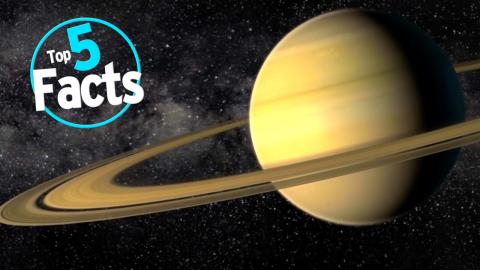Top 5 Facts About Saturn

It's literally one of the coolest planets in our Solar System – figuratively so too. Welcome to WatchMojo's Top 5 Facts. In this instalment we're counting down the five most fascinating things that you probably didn't know about Saturn!
Special thanks to our user MikeMJPMUNCH for submitting the idea on our Interactive Suggestion Tool at http://www.WatchMojo.comsuggest
#5: Summer in Saturn Lasts 8 Years
Given that Saturn is 1.4 billion kilometres from the Sun, while Earth, is a mere 149 million kilometres away, a year on Saturn is equivalent to 29.4 Earth years. Saturn does have an axial tilt similar to ours, meaning that it is also subject to theoretical seasons. However, a single season on Saturn lasts between 7 and 8 years. An 8-year summer might be enviable, but just imagine the comparable winter that follows! That being said, not every unit of time is longer on Saturn. It spins with greater speed on its axis compared to Earth, which means that one day only lasts for around 10 and a half Earth hours.
#4: Saturn Blows
Saturn is comprised of gas and is the least dense planet in the Solar System, made up of 94% hydrogen, 6% helium, and small amounts of methane. But that doesn’t mean it’s a light and airy place. What Saturn lacks in density it more than makes up for with wind speed. The weather patterns on the planet are incredibly extreme. Winds can gust over 1000 mph, storms can last for months, and its lightning is up to 1000 times more powerful than Earth’s. Think of the gigawatts!
#3: There Could Be Life on One of Saturn's Many Moons
NASA says that Saturn has 62 confirmed moons, with 53 of them named, with the majority less than 50km across. The aptly named ‘Titan’ is the largest, however, dwarfing even the planet Mercury in terms of size. Titan is the only moon in the Solar System to possess its own atmosphere, meaning researchers are intent upon exploring it; the Titan Saturn System Mission will be launched in 2020 at a cost of $2.5 billion. The Cassini-Huygens mission is already underway, though, investigating Titan and another moon, Enceladus. The probe is sweeping close to the surface of Enceladus, in search of atmospheric anomalies and signs of alien life. Enceladus is mostly made of ice, beneath which scientists believe there could exist some kind of alien ocean.
#2: Humans Could Fly on Titan
Technically speaking, if ever mankind found itself on Saturn’s largest moon, Titan, then it could strap on a set of wings and take to the skies. The combination of high air density and low gravity on Titan, means if you run fast enough you could take off. Students in England have estimated that you’d have to clock a groundspeed of 11m per second before flapping your arms around, however, which is a tough ask considering Usain Bolt runs only marginally quicker at 12 m/s. And, if you ever did achieve flight, then you’d do best not to soar too close to Saturn itself. The atmospheric pressure there is 100 times greater than Earth’s; it’s strong enough to turn liquid into gas, and it’d crush a human being instantly.
#1: Saturn's Rings Will One Day Disappear
Though it isn’t actually the only planet with ‘rings’ – Jupiter, Neptune and Uranus also have them – Saturn’s rings are easily the biggest and best example of the phenomena in our Solar System. But, they will not be around forever. Scientists predict that over time the rings – which are just 20 meters thick in some areas, and are made of bits of ice and rock – will either expand outwards, gradually floating away from their planet, or else succumb to Saturn’s gravitational force and fall inwards. At present, the rings stretch around 120,000km from the planet itself, however, and their disbanding is not expected for millions of years.
So, have these facts inspired you to go telescope shopping? Which planet fascinates you the most? For more out-of-this-world Top 10s and will-disappear-someday Top 5s, be sure to subscribe to WatchMojo.com!


 0
0
 1
1
 report
report

 0
0
 1
1
 report
report